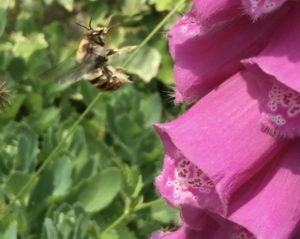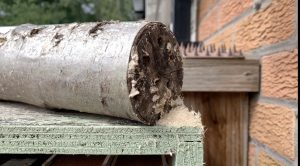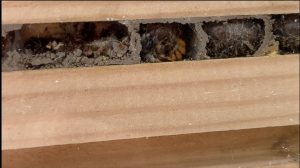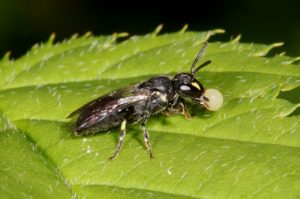27 solitary bee flowers by Nurturing Nature
27 flowers used by solitary bees for nectar and pollen Each one of the flowers is actually used by and in most cases, bees have been filmed actually foraging or has just finished foraging on it. All flowers were filmed in my garden, except for the parsnips growing on...
Gardening for bumblebees by Dave Goulson my review
Gardening for Bumbeless- A Practical Guide to Creating a Paradise for Pollinators By Dave Goulson As with his other popular books, Professor Dave Goulson has this canny knack of using his vast academic experience, mixing it with practical experiences and then...
Male Semaphore flies and their elaborate courtship ritual on my pond!
Semaphore flies What a great name for these male flies with the semaphore-like courtship ritual. A little easier than their scientific name Poecilobothrus nobilitatus! They did remind me of the semaphore flag signals as used by the navy when signalling from one ship...
Hedgehog enters garden using a Hedgehog Highway then walks the plank!
Hedgehog enters garden using a Hedgehog Highway then walks the plank! Hedgehog Highways absolutely work and the more of them we can create the more likelihood hedgehogs will be seen alive in your garden and not dead in the road. Those concrete gravel boards may make...
Heriades truncorum (large headed resin bee) dabbing pollen onto its abdomen when foraging
Heriades truncorum, Large-headed resin bee, a specialist forager I have had many reports over the years, usually from areas down in the south-east, regarding these bees using my Nurturing Nature solitary bee observation nest box. BWARS states that this bee is...
Stelis breviuscula using nest box resident Heriades truncorum, the Resin bee as a host
Heriades truncorum The Large-headed Resin Bee An interesting new addition to the bees using a Nurturing Nature observation nest box was recently found and photographed by Dr Hauke Koch at Kew Gardens. This time it is Stelis breviuscula a cleptoparasite of Heriades...
Ectemnius solitary wasps using a Nurturing Nature nest box
Ectemnius solitary wasps Although there are several species of Ectemnius solitary wasps in the UK, I think probably the ones in the film are male Ectemnius continuus. which according to Jeremy Early, are very similar in appearance is E. rupicola. This species...
What is a vestibular cell in a Red mason bee nest?
What is the vestibular cell in a Red mason bee nest? In the photograph below you will see all but one cell (red star) has what is called a vestibulum, (pl. vestibuli). This is the outermost cell within a nesting cavity and is usually an empty cell, with no provisions,...
How do Red mason bees get out of their mud cells?
The mud cells inside a Red mason bee nest are very hard. Many people know that Red mason bee females seal their cells with mud to protect their offspring from potential harm and to keep the internal cell environment conducive to the success of its contents. The mud...
Life cycle of the Common yellow-face bee (Hylaeus communis)
The life cycle of the Common yellow-face bee (Hylaeus communis) Certainly one of our smallest solitary bees the Common yellow face bee is only 4-5mm. BWARS described its nesting biology as "An opportunistic cavity-nester, utilising existing burrows of a suitable...









